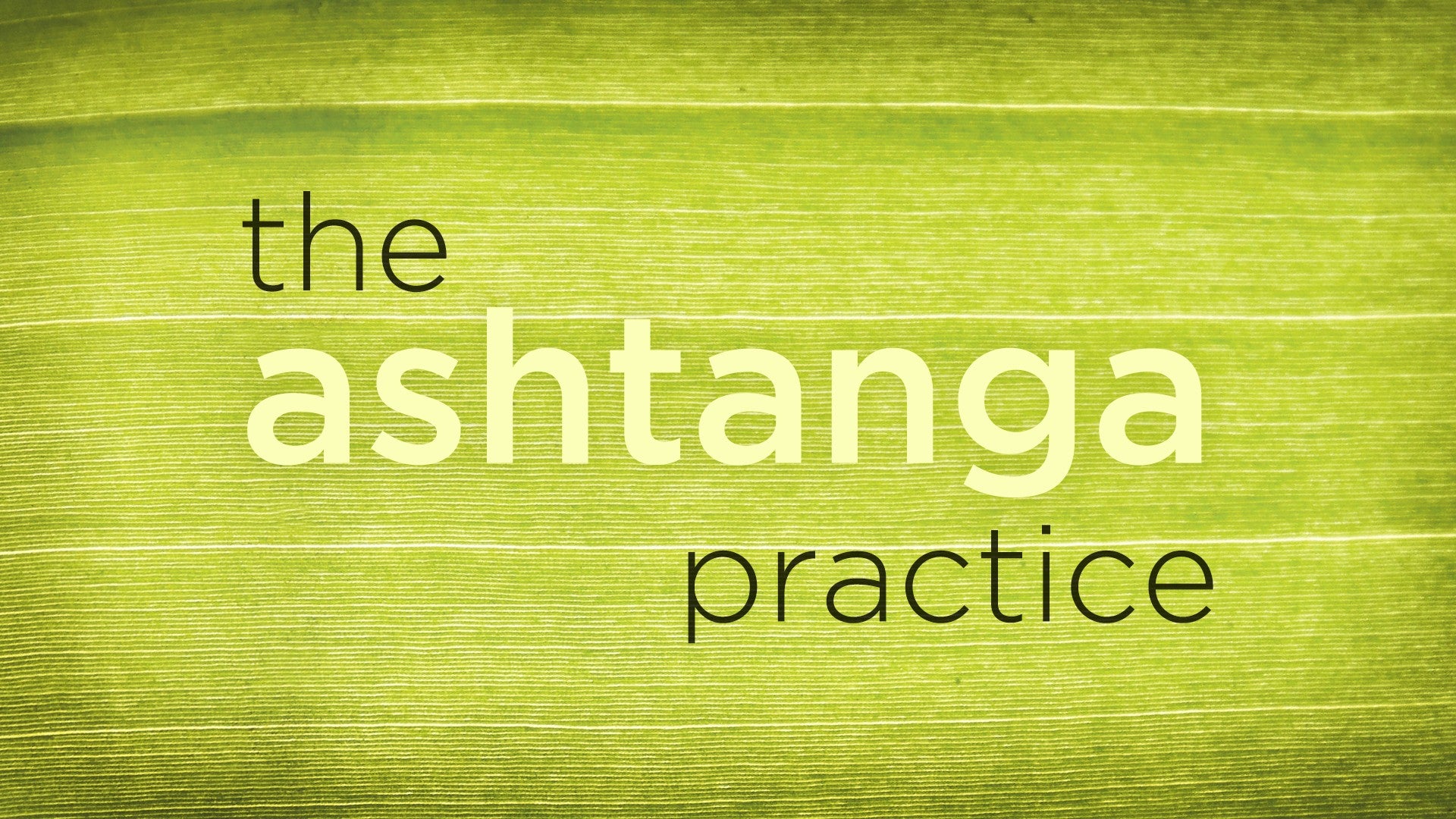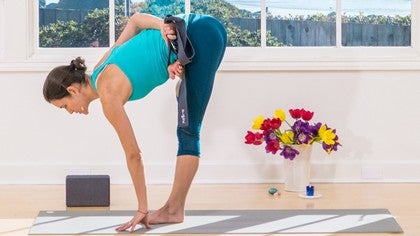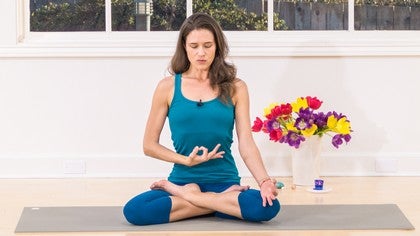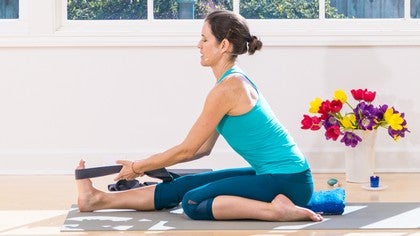Description
About This Video
Transcript
Read Full Transcript
(waves crashing) Hello and welcome back. So in this section, I'd like to break down some of the standing poses in the primary series. But before we do that, spend just a little time cleaning up the vinyasas. I see a lot of variations and permutations with the vinyasas, and I think it's worthwhile just to zero in on it for a moment or two and make sure the alignment is intelligent and also, to offer a couple variations for the full Chaturanga if you need to conserve energy on any given day, or just doing the entire vinyasa is a little bit too much. Okay?
So for this section, you'll probably want a strap and a block, have those handy. And we'll start in downward-facing dog. (deep breathing) All right. So coming into the posture, give yourself a few breaths just to ease into it and warm the body. (deep breathing) Find a deep full Ujjayi breath.
(deep breathing) All right, so, traditionally you would inhale forward into plank pose, where you would arrive in plank pose after jumping back, and for Chaturanga Dandasana we want to keep a 90 degree angle with the elbows and have the shoulders lower no closer to the earth than the elbows. So strong through the entire body. Exhale as you lower, hug the elbows in, coming forward a little. From there, inhale, press up into upward-facing dog. From the core and the hips, exhale, go back into downward-facing dog.
So over time you will save your joints and really build the upper body strength if you can maintain that alignment. Let's take it one more time. Inhale to plank. Exhale, lower. (deep breathing) Inhale, upward-facing.
And exhale, downward-facing. (deep breathing) So if you're fatigued, if there's any pain in the joints, in the elbows, and you want a variation, you can inhale forward to plank. Exhale, lower the knees. And then just ease the entire body down. Elbows in towards the chest, and then instead of full upward-facing dog, inhale, take just a gentle cobra as high as feels good in your body.
Shoulders down, heart rising. And exhale, back onto the hands and the knees. All the way to downward dog. (deep breathing) Take a breath or two here. (deep breathing) And let's take that again together.
Inhale to plank. Exhale, lower the knees. Keep the elbows in. Ease the whole upper body down. Inhale, cobra just as high as feels best.
And exhale, go back to the hands and the knees. All the way to downward dog. (deep breathing) Beautiful. And then just gently walk the feet forward. Take a moment.
(deep breathing) Soft through the knees, inhale, roll yourself all the way up to stand. All right. Let's move into some standing poses from here. Just a simple Trikonasana, triangle pose. Right forward, left foot back.
Traditionally in the Ashtanga practice, we reach out and we take hold of that big toe, but if for any reason that's just too much, you can rest the hand just below the knee on the shin, down towards the ankle. Or grab the block and take it at any height. This is the beauty of a block, you can take it at its highest level and then if you feel the body starting to open, you can lower it down midway, or even a little closer to the earth. So any variation that serves. And then rolling the torso open and extending that left arm up to the sky.
So more important in this posture to get the length through the spine, the engagement through the legs, the opening of the torso, rather than having the hand anywhere in particular. So please feel free to draw the hand up the leg or grab the block if that helps to open the rest of the posture. Let's pause here for a few breaths and just feel into it. (deep breathing) And then inhale, come on up. You can take the block with you as you transition to the other side, pivoting to the left foot.
Just place the block wherever you want it. Inhale, take the right arm up. Find that length out through the spine. Easing up towards the right fingertips. Breathe here.
(deep breathing) And then inhale to come on back up. So same idea with twisting triangle. We'll pivot back to the right. Very, very challenging to get that hand to the outer edge of the front foot. So, quite a few options.
You can take the block down inside of that front foot, again, at any height that feels best. And then move into this really slowly and mindfully. Draw the right hand to the hip. Press through the feet, extend out through the heart so you get some length in the spine. And then begin to twist from there.
So spiraling open through the torso. You can work with that for a breath or two. Then if you feel for it, take the right arm up to the sky. We'll breathe here. (deep breathing) And slowly take the block with you, inhale, come on up and pivot over to the left.
Alright? So same principles here. Even out through the hips. Ground that right hand. You may find you're able to take the block a little bit lower.
You may find you're able to take the block outside of the front foot. Again, just play with it. Do what's possible. Left hand to the left hip. Take a moment here to lengthen out through the spine.
Then spiral up to the left. And when you're ready take that left arm up. And we'll breathe. (deep breathing) Gently release and inhale, come on back up. Alright, good.
And moving into side angle Parsvakonasana. Few options here, block down for the time being. So full expression of the pose. Essentially foundation of Warrior II. And then the right hand comes down outside of the right foot.
However, if that's too intense really nice option is to just take the right forearm to the right thigh, palm facing up and then reach the left arm up and over from here. You wanna lift gently the gaze up and under that left arm. And keep rolling the pinky-side edge of that left arm down towards the earth. So it's a little counter intuitive as the torso rolls open that left arm rolls down. Let's breathe here.
(deep breathing) And then inhale come on up. Let's grab the block for this side for another variation. Twisting to the left, Take the block just outside the foot nice and high. So if you're really comfortable in this variation then you wanna take it a little bit deeper. Drop that left hand to the block and reach out from there.
And if you feel you can deepen it over time lower the block closer to the earth. Keep rolling the torso open towards the sky. Roll that right arm in and down a little. Lift the gaze. Take a few breaths.
(deep breathing) And inhale go ahead and come on back up. Alright, Twisting side-angle. Let's pivot back to the right. Place the block nice and high outside of that right foot. Same as twisting triangle we want to really take our time coming into this pose, drawing the right hip back left hip forward.
Inhale reach the left arm up And exhale begin just by drawing that left elbow outside of that right knee. That can be plenty. If so stack the hands in prayer and twist from there. Use the resistance of the knee pressing out, the elbow pressing in to open. (deep breathing) Breathing.
(deep breathing) To come up inhale, take the block with you. (deep breathing) Outside of that left foot. Let's begin in the same way. Take your time easing the hips forward. Take a big inhale and exhale twist, hook that right elbow just outside of the knee and spiral the spine.
If this is enough: stay there. If you'd like to try: slide the right arm a little bit further. And plant the hand on the block. Then lift the left arm up and over. Breathing here.
(deep breathing) And inhale all the way back up. Excellent. Okay. Let's move into some standing balancing poses. Block off to the side for the time being. And grab your strap for Utthita Hasta Padangusthasana.
Everyone's favorite pose. Don't worry about the full extension of the leg. Don't worry about grabbing the toe. Just use your strap. You're going to ground through that right foot.
Loop the strap around the ball of the right foot. And then slowly extend out from there. Be mindful of where your buckle drops. (deep breathing) And slowly just begin to lift the leg. (deep breathing) If you feel fairly steady here you can keep the strap in the right hand and release the left hand to the hip.
(deep breathing) Take a couple breaths. (deep breathing) And then keep hold of the strap and use it to guide the right leg out to the right. If you're really wobbly just work with what you've got. If you feel steady gaze goes over the left shoulder. Breathing. Three.
(deep breathing) Two. (deep breathing) And then gently inhale drop back in if possible reach forward with both hands and just try bowing forward to the leg for a breath. And then gently releasing. And same premise with any use of the strap over time you'll be able to walk your hands a little closer to the foot until you can grab it. The other option, if the strap itself is too intense we'll take it on the other side so ground through the right foot.
Draw the left leg up and just keep the knee bent. Interlace the hands around the shin. Work on lengthening the spine. Drawing the knee in. Drawing the core in and up.
Steady here, a couple breaths. (deep breathing) And then try taking the knee, the shin just with the left hand, right hand to the hip and open it out from there. If you're steady gaze over that right shoulder. (deep breathing) And then go ahead and inhale. Come back to center.
Hold the shin again with both hands and exhale. Just bow to the leg one breath. (deep breathing) And release. One more. Ardha Baddha Padmottanasana.
If possible you're going to draw that right foot all the way up into half lotus. If this is too much for the knee or the ankle you can work just with balancing in tree pose. Or you can take that right ankle just beyond the left knee. Flex that right foot to protect the right knee. And breath there.
Little by little work on drawing the foot up. Eventually if you can get it as far as Half Lotus, but you can't quite wrap it around for the bind grab the strap (chuckling) and loop it around the foot. And then just go back with the right arm and take hold. If this is really really intense then stay here. Breathe into what you've got.
Let it gradually open. Let it gradually lift a little higher. Maybe the hand walks a little closer to the foot. Can keep holding with the left for support. If you feel relatively steady there's no pain in the knee or the ankle you can use the strap and take the fold.
Easing down, hand on the earth. Don't worry too much about the placement as you're starting out. Just find the balance. And if you're steady come into the full fold. (deep breathing) Take a couple breathes.
(deep breathing) Be really mindful as you're newer to this pose. Coming out of it is important. You wanna inhale halfway up. (deep breathing) Take a full exhale here. (deep breathing) And then inhale come all the way up.
Exhale release. I find if I don't take that breath halfway through I get a little dizzy or light-headed. So take that time. Let's do it on the second side. Really solidify the options.
Ground through the right foot. Left foot can come into Tree. Can be ankle across the knee and just work with that. Or slowly moving up into Half Lotus. Take the strap around the foot.
Left arm back. And again, if this is enough stay here. Deep breath, steady gaze. Work on this gradually opening. If you feel pretty grounded big inhale and exhale, ease forward.
Plant the right hand. And melt into the fold. Give it a few breaths. (deep breathing) Coming out slowly inhale halfway up. (deep breathing) Exhale.
(deep breathing) Inhale all the way up. (deep breathing) And exhale, release. Beautiful, I hope that helps. Enjoy, Namaste.
The Ashtanga Practice: Rosemary Garrison
Comments
You need to be a subscriber to post a comment.
Please Log In or Create an Account to start your free trial.











